NCERT Solutions Class 12 Chemistry Chapter 3 - Chemical Kinetics
Page No.66 - Intext Questions
Q3.1: For the reaction R → P, the concentration of a reactant changes from 0.03 M to 0.02 M in 25 minutes. Calculate the average rate of reaction using units of time both in minutes and seconds.
Ans: Average rate of reaction


= 6.67 × 10−6 M s−1
Q3.2: In a reaction, 2A → Products, the concentration of A decreases from 0.5 mol L−1 to 0.4 mol L−1 in 10 minutes. Calculate the rate during this interval?
Ans:

= 0.005 mol L−1 min−1
= 5 × 10−3 M min−1
Page No.71 - Intext Questions
Q3.3: For a reaction, A + B → Product; the rate law is given by, r = k [ A]1/2 [B]2. What is the order of the reaction?
Ans: The order of the reaction = 

Q3.4: The conversion of molecules X to Y follows second order kinetics. If concentration of X is increased to three times how will it affect the rate of formation of Y?
Ans: The reaction X → Y follows second order kinetics.
Therefore, the rate equation for this reaction will be:
Rate = k [X]2 (1)
Let [X] = a mol L−1, then equation (1) can be written as:
Rate1 = k.(a)2 = ka2
If the concentration of X is increased to three times, then [X] = 3a mol L−1
Now, the rate equation will be:
Rate = k (3a)2 = 9(ka2)
Hence, the rate of formation will increase by 9 times.
Page No.78 - Intext Questions
Q3.5: A first order reaction has a rate constant 1.15 10−3 s−1. How long will 5 g of this reactant take to reduce to 3 g?
Ans: From the question, we can write down the following information:
Initial amount = 5 g
Final concentration = 3 g
Rate constant = 1.15 10−3 s−1
We know that for a 1st order reaction,

= 444.38 s
= 444 s (approx)
Q3.6: Time required to decompose SO2Cl2 to half of its initial amount is 60 minutes. If the decomposition is a first order reaction, calculate the rate constant of the reaction.
Ans: We know that for a 1st order reaction,
It is given that t1/2 = 60 min
= 0.693/60
= 0.01155 min-1
= 1.155 min-1
Or k = 1.925 x 10-4 s-1
Page No.84 - Intext Questions
Q3.7: What will be the effect of temperature on rate constant?
Ans: With increase in temperature, the rate of the reaction and the rate constant increases. As a generalization, the rate of the reaction (and the rate constant) becomes almost double for every ten degree rise in temperature. This is also called temperature coefficient.
Q3.8: The rate of the chemical reaction doubles for an increase of 10 K in absolute temperature from 298 K. Calculate Ea.
Ans: It is given that T1 = 298 K
∴T2 = (298 + 10) K
= 308 K
We also know that the rate of the reaction doubles when temperature is increased by 10°.
Therefore, let us take the value of k1 = k and that of k2 = 2k
Also, R = 8.314 J K−1 mol−1
Now, substituting these values in the equation: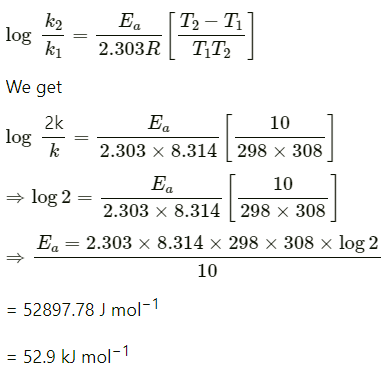
Q3.9: The activation energy for the reaction
2HI(g) → H2 + I2(g)
is 209.5 kJ mol−1 at 581K. Calculate the fraction of molecules of reactants having energy equal to or greater than activation energy?
Ans: In the given case:
Ea = 209.5 kJ mol−1 = 209500 J mol−1
T = 581 K
R = 8.314 JK−1 mol−1
Now, the fraction of molecules of reactants having energy equal to or greater than activation energy is given as:
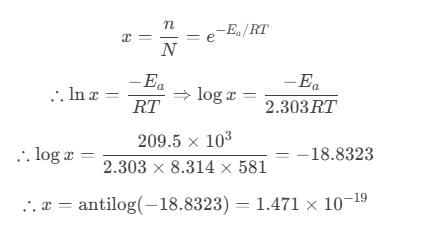
Exercises
Q3.1: From the rate expression for the following reactions, determine their order of reaction and the dimensions of the rate constants.
(i) 3 NO(g) → N2O (g) Rate = k[NO]2
(ii) H2O2 (aq) + 3 I− (aq) 2 H → 2 H2O (l) +  Rate = k[H2O2][I−]
Rate = k[H2O2][I−]
(iii) CH3CHO(g) → CH4(g) + CO(g) Rate = k [CH3CHO]3/2
(iv) C2H5Cl(g) → C2H4(g) + HCl(g) Rate = k [C2H5Cl]
Ans: (i) Given rate = k [NO]2
Therefore, order of the reaction = 2
Dimension of 

(ii) Given rate = k [H2O2] [I−]
Therefore, order of the reaction = 2
Dimension of 

(iii) Given rate = k [CH3CHO]3/2
Therefore, order of reaction = 3/2
Dimension of 

(iv) Given rate = k [C2H5Cl]
Therefore, order of the reaction = 1
Dimension of 

Q3.2: For the reaction:
2A + B → A2B
the rate = k[A][B]2 with k = 2.0 × 10−6 mol−2 L2 s−1. Calculate the initial rate of the reaction when [A] = 0.1 mol L−1, [B] = 0.2 mol L−1. Calculate the rate of reaction after [A] is reduced to 0.06 mol L−1.
Ans: The initial rate of the reaction is
Rate = k [A][B]2
= (2.0 × 10−6 mol−2 L2 s−1) (0.1 mol L−1) (0.2 mol L−1)2
= 8.0 × 10−9 mol−2 L2 s−1
When [A] is reduced from 0.1 mol L−1 to 0.06 mol−1, the concentration of A reacted = (0.1 − 0.06) mol L−1 = 0.04 mol L−1
Therefore, concentration of B reacted = 0.02 mol L−1
Then, concentration of B available, [B] = (0.2 − 0.02) mol L−1
= 0.18 mol L−1
After [A] is reduced to 0.06 mol L−1, the rate of the reaction is given by,
Rate = k [A][B]2
= (2.0 × 10−6 mol−2 L2 s−1) (0.06 mol L−1) (0.18 mol L−1)2
= 3.89 × 10−9 mol L−1 s−1
Q3.3: The decomposition of NH3 on platinum surface is zero order reaction. What are the rates of production of N2 and H2 if k = 2.5 × 10−4 mol−1 L s−1?
Ans: The decomposition of NH3 on platinum surface is represented by the following equation.

Therefore,

However, it is given that the reaction is of zero order.
Therefore,

Therefore, the rate of production of N2 is

And, the rate of production of H2 is

= 7.5 × 10−4 mol L−1 s−1
Q3.4: The decomposition of dimethyl ether leads to the formation of CH4, H2 and CO and the reaction rate is given by Rate = k [CH3OCH3]3/2
The rate of reaction is followed by increase in pressure in a closed vessel, so the rate can also be expressed in terms of the partial pressure of dimethyl ether, i.e.,

If the pressure is measured in bar and time in minutes, then what are the units of rate and rate constants?
Ans: The rate of reaction is defined as the change in pressure per unit time:
- Since pressure (p) is measured in bar and time (t) in minutes,
- The units of rate are: bar min−1
The rate law is:


Therefore, unit of rate constants

Q3.5: Mention the factors that affect the rate of a chemical reaction.
Ans: The factors that affect the rate of a reaction are as follows.
(i) Concentration of reactants (pressure in case of gases)
(ii) Temperature
(iii) Presence of a catalyst
Q3.6: A reaction is second order with respect to a reactant. How is the rate of reaction affected if the concentration of the reactant is (i) doubled (ii) reduced to half?
Ans: Let the concentration of the reactant be [A] = a
Rate of reaction, R = k [A]2
= ka2
(i)If the concentration of the reactant is doubled, i.e. [A] = 2a, then the rate of the reaction would be

= 4ka2
= 4 R
Therefore, the rate of the reaction would increase by 4 times.
(ii) If the concentration of the reactant is reduced to half, i.e.  , then the rate of the reaction would be
, then the rate of the reaction would be

=1/4 ka2
=1/4 R
Therefore, the rate of the reaction would be reduced to 1/4 th.
Q3.7: What is the effect of temperature on the rate constant of a reaction? How can this temperature effect on the rate constant be represented quantitatively?
Ans: The rate constant of a reaction increases with increase of temperature and becomes nearly double for every 10° rise of temperature. The effect can be represented quantitatively by Arrhenius equation,
k = Ae-Ea/RT
Where,
A = Arrhenius constant
Ea = Activation energy
R = Gas constant
T = Temperature
k = Rate Constant
Q3.8: In a pseudo first order hydrolysis of ester in water, the following results were obtained:
(i) Calculate the average rate of reaction between the time interval 30 to 60 seconds.

(ii) Calculate the pseudo first order rate constant for the hydrolysis of ester.
Ans: (i) Average rate of reaction between the time interval, 30 to 60 seconds,

= 4.67 × 10−3 mol L−1 s−1
(ii) For a pseudo first order reaction,

For t = 30 s, 
= 1.911 × 10−2 s−1
For t = 60 s, 
= 1.957 × 10−2 s−1

For t = 90 s,
= 2.075 × 10−2 s−1
Then, average rate constant,

Q3.9: A reaction is first order in A and second order in B.
(i) Write the differential rate equation.
(ii) How is the rate affected on increasing the concentration of B three times?
(iii) How is the rate affected when the concentrations of both A and B are doubled?
Ans: (i) The differential rate equation will be

(ii) If the concentration of B is increased three times, then

Therefore, the rate of reaction will increase 9 times.
(iii) When the concentrations of both A and B are doubled,

Therefore, the rate of reaction will increase 8 times.
Q3.10: In a reaction between A and B, the initial rate of reaction (r0) was measured for different initial concentrations of A and B as given below:
What is the order of the reaction with respect to A and B?
Ans: Let the order of the reaction with respect to A be x and with respect to B be y.
Therefore,

Dividing equation (i) by (ii), we obtain

Dividing equation (iii) by (ii), we obtain

= 1.496
= 1.5 (approximately)
Hence, the order of the reaction with respect to A is 1.5 and with respect to B is zero.
Q3.11: The following results have been obtained during the kinetic studies of the reaction:
2A + B → C + D
Determine the rate law and the rate constant for the reaction.
Ans: Let the order of the reaction with respect to A be x and with respect to B be y.
Therefore, rate of the reaction is given by,
According to the question,

Dividing equation (iv) by (i), we obtain


Dividing equation (iii) by (ii), we obtain

Therefore, the rate law is
Rate = k [A] [B]2


From experiment I, we obtain

= 6.0 L2 mol−2 min−1
From experiment II, we obtain

= 6.0 L2 mol−2 min−1
From experiment III, we obtain

= 6.0 L2 mol−2 min−1
From experiment IV, we obtain

= 6.0 L2 mol−2 min−1
Therefore, rate constant, k = 6.0 L2 mol−2 min−1
Q3.12: The reaction between A and B is first order with respect to A and zero order with respect to B. Fill in the blanks in the following table:
Ans: The given reaction is of the first order with respect to A and of zero order with respect to B.
Therefore, the rate of the reaction is given by,
Rate = k [A]1 [B]0
⇒ Rate = k [A]
From experiment I, we obtain
2.0 × 10−2 mol L−1 min−1 = k (0.1 mol L−1)
⇒ k = 0.2 min−1
From experiment II, we obtain
4.0 × 10−2 mol L−1 min−1 = 0.2 min−1 [A]
⇒ [A] = 0.2 mol L−1
From experiment III, we obtain
Rate = 0.2 min−1 × 0.4 mol L−1
= 0.08 mol L−1 min−1
From experiment IV, we obtain
2.0 × 10−2 mol L−1 min−1 = 0.2 min−1 [A]
⇒ [A] = 0.1 mol L−1
Q3.13: Calculate the half-life of a first order reaction from their rate constants given below:
(i) 200 s−1
(ii) 2 min−1
(iii) 4 years−1
Ans: (i) Half life,

=0.693 / 200s-1 = 3.47 x 10-3 s (approximately)
(ii) Half life,

 = 0.35 min (approximately)
= 0.35 min (approximately)
(iii) Half life,

= 0.173 years (approximately)
Q3.14: The half-life for radioactive decay of 14C is 5730 years. An archaeological artifact containing wood had only 80% of the 14C found in a living tree. Estimate the age of the sample.
Ans: Here,

It is known that,

= 1845 years (approximately)
Hence, the age of the sample is 1845 years.
Q3.15: The experimental data for decomposition of N2O5  in gas phase at 318K are given below:
in gas phase at 318K are given below:

(i) Plot [N2O5] against t.
(ii) Find the half-life period for the reaction.
(iii) Draw a graph between log [N2O5] and t.
(iv) What is the rate law?
(v) Calculate the rate constant.
(vi) Calculate the half-life period from k and compare it with (ii).
Ans: (i)

(ii) Time corresponding to the concentration  , is the half life. From the graph, the half life is obtained as 1450 s.
, is the half life. From the graph, the half life is obtained as 1450 s.
(iii)
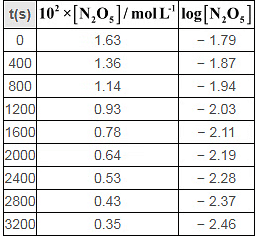
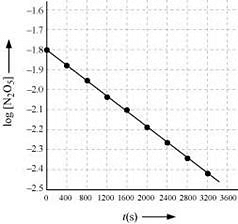
(iv) The given reaction is of the first order as the plot,  v/s t, is a straight line. Therefore, the rate law of the reaction is
v/s t, is a straight line. Therefore, the rate law of the reaction is

(v) From the plot,  v/s t, we obtain
v/s t, we obtain

Again, slope of the line of the plot  v/s t is given by
v/s t is given by
 .
.
Therefore, we obtain,


(vi) Half-life is given by,
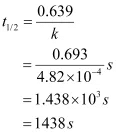
This value, 1438 s, is very close to the value that was obtained from the graph.
Q3.16: The rate constant for a first order reaction is 60 s−1. How much time will it take to reduce the initial concentration of the reactant to its 1/16th value?
Ans: It is known that,


Hence, the required time is 4.6 × 10−2 s.
Q3.17: During nuclear explosion, one of the products is 90 Sr with half-life of 28.1 years. If 1μg of 90 Sr was absorbed in the bones of a newly born baby instead of calcium, how much of it will remain after 10 years and 60 years if it is not lost metabolically.
Ans: Here,

It is known that,


Therefore, 0.7814 μg of 90 Sr will remain after 10 years.
Again,


Therefore, 0.2278 μg of 90 Sr will remain after 60 years.
Q3.18: For a first order reaction, show that time required for 99% completion is twice the time required for the completion of 90% of reaction.
Ans: For a first order reaction, the time required for 99% completion is

For a first order reaction, the time required for 90% completion is

Therefore, t1 = 2t2
Hence, the time required for 99% completion of a first order reaction is twice the time required for the completion of 90% of the reaction.
Q3.19: A first order reaction takes 40 min for 30% decomposition. Calculate t1/2.
Ans: For a first order reaction,


Therefore, t1/2 of the decomposition reaction is

= 77.7 min (approximately)
Q3.20: For the decomposition of azoisopropane to hexane and nitrogen at 543 K, the following data are obtained.
Calculate the rate constant.
Ans: The decomposition of azoisopropane to hexane and nitrogen at 543 K is represented by the following equation.

After time, t, total pressure, 

= 2P0 − Pt
For a first order reaction,

When t = 360 s, 
= 2.18 × 10−3 s−1
When t = 720 s, 
= 2.24 × 10−3 s−1
Hence, the average value of rate constant is
= 2.21 × 10−3 s−1
Note: There is a slight variation in this answer and the one given in the NCERT textbook.
Q3.21: The following data were obtained during the first order thermal decomposition of SO2Cl2 at a constant volume.

Calculate the rate of the reaction when total pressure is 0.65 atm.
Ans: The thermal decomposition of SO2Cl2 at a constant volume is represented by the following equation.

After time, t, total pressure, 

Therefore, 
= 2 P0 − Pt
For a first order reaction,

When t = 100 s, 
= 2.231 × 10−3 s−1
When Pt = 0.65 atm,
P0 p = 0.65
⇒ p = 0.65 − P0
= 0.65 − 0.5
= 0.15 atm
Therefore, when the total pressure is 0.65 atm, pressure of SOCl2 is
 = P0 − p
= P0 − p
= 0.5 − 0.15
= 0.35 atm
Therefore, the rate of equation, when total pressure is 0.65 atm, is given by,
Rate = k( )
)
= (2.23 × 10−3 s−1) (0.35 atm)
= 7.8 × 10−4 atm s−1
Q3.22: The rate constant for the decomposition of N2O5 at various temperatures is given below:
Draw a graph between ln k and 1/T and calculate the values of A and Ea. Predict the rate constant at 30º and 50ºC.
Ans: From the given data, we obtain

Slope of the line,

According to Arrhenius equation,

Again,



When  ,
,

Then, 

Again, when  ,
,

Then, at  ,
,

Q3.23: The rate constant for the decomposition of hydrocarbons is 2.418 × 10−5 s−1 at 546 K. If the energy of activation is 179.9 kJ/mol, what will be the value of pre-exponential factor.
Ans: k = 2.418 × 10−5 s−1
T = 546 K
Ea = 179.9 kJ mol−1 = 179.9 × 103 J mol−1
According to the Arrhenius equation,

= (0.3835 − 5) 17.2082
= 12.5917
Therefore, A = antilog (12.5917)
= 3.9 × 1012 s−1 (approximately)
Q3.24: Consider a certain reaction A → Products with k = 2.0 × 10−2 s−1. Calculate the concentration of A remaining after 100 s if the initial concentration of A is 1.0 mol L−1.
Ans: k = 2.0 × 10−2 s−1
T = 100 s
[A]o = 1.0 moL−1
Since the unit of k is s−1, the given reaction is a first order reaction.
Therefore, 


= 0.135 mol L−1 (approximately)
Hence, the remaining concentration of A is 0.135 mol L−1.
Q3.25: Sucrose decomposes in acid solution into glucose and fructose according to the first order rate law, with t1/2 = 3.00 hours. What fraction of sample of sucrose remains after 8 hours?
Ans: For a first order reaction,

It is given that, t1/2 = 3.00 hours
Therefore, 

= 0.231 h−1
Then, 0.231 h−1

Hence, the fraction of sample of sucrose that remains after 8 hours is 0.158.
Q3.26: The decomposition of hydrocarbon follows the equation k = (4.5 × 1011 s−1) e−28000 K/T Calculate Ea.
Ans: The given equation is
k = (4.5 × 1011 s−1) e−28000 K/T (i)
Arrhenius equation is given by,
 (ii)
(ii)
From equation (i) and (ii), we obtain

= 8.314 J K−1 mol−1 × 28000 K
= 232792 J mol−1
= 232.792 kJ mol−1
Q3.27: The rate constant for the first order decomposition of H2O2 is given by the following equation:
log k = 14.34 − 1.25 × 104 K/T
Calculate Ea for this reaction and at what temperature will its half-period be 256 minutes?
Ans: Arrhenius equation is given by,


The given equation is

From equation (i) and (ii), we obtain

= 1.25 × 104 K × 2.303 × 8.314 J K−1 mol−1
= 239339.3 J mol−1 (approximately)
= 239.34 kJ mol−1
Also, when t1/2 = 256 minutes,

= 2.707 × 10−3 min−1
= 4.51 × 10−5 s−1
It is also given that, log k = 14.34 − 1.25 × 104 K/T

= 668.95 K
= 669 K (approximately)
Q3.28: The decomposition of A into product has value of k as 4.5 × 103 s−1 at 10°C and energy of activation 60 kJ mol−1. At what temperature would k be 1.5 × 104 s−1?
Ans: From Arrhenius equation, we obtain

Also, k1 = 4.5 × 103 s−1
T1 = 273 10 = 283 K
k2 = 1.5 × 104 s−1
Ea = 60 kJ mol−1 = 6.0 × 104 J mol−1
Then,

= 297 K
= 24°C
Hence, k would be 1.5 × 104 s−1 at 24°C.
Note: There is a slight variation in this answer and the one given in the NCERT textbook.
Q3.29: The time required for 10% completion of a first order reaction at 298 K is equal to that required for its 25% completion at 308 K. If the value of A is 4 × 1010 s−1. Calculate k at 318 K and Ea.
Ans: For a first order reaction,

At 298 K,

At 308 K,

According to the question,

From Arrhenius equation, we obtain

To calculate k at 318 K,
It is given that, 
Again, from Arrhenius equation, we obtain


Q3.30: The rate of a reaction quadruples when the temperature changes from 293 K to 313 K. Calculate the energy of activation of the reaction assuming that it does not change with temperature.
Ans: From Arrhenius equation, we obtain

Hence, the required energy of activation is 52.86 kJmol−1.
|
75 videos|278 docs|78 tests
|
FAQs on NCERT Solutions Class 12 Chemistry Chapter 3 - Chemical Kinetics
| 1. What is the rate law in chemical kinetics? |  |
| 2. How do you determine the order of a reaction experimentally? |  |
| 3. What factors affect the rate of a chemical reaction? |  |
| 4. What is a half-life in the context of chemical kinetics? |  |
| 5. What is the difference between a zero-order and a first-order reaction? |  |

















